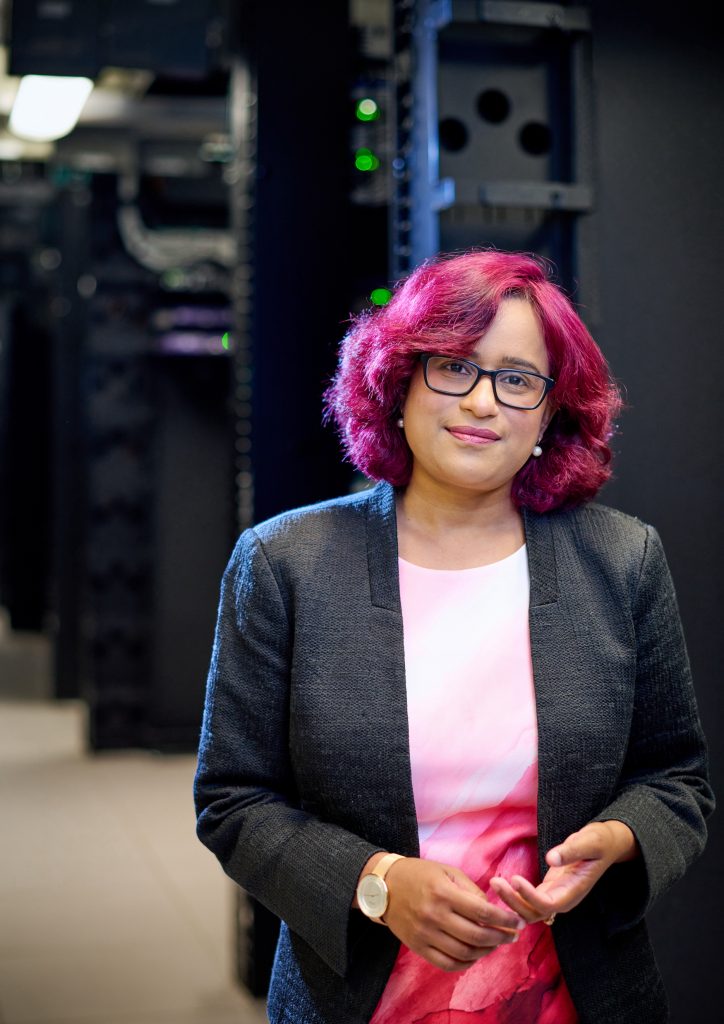Research Computing’s supercomputer Longleaf is now benefiting outside researchers in addition to those at UNC-Chapel Hill.
Two separate UNC-Greensboro researchers with high computational needs are availing themselves of this specialized, powerful platform that is not common outside of a flagship university like Carolina.

Longleaf is UNC-Chapel Hill’s flagship computing and analytics cluster. What’s so special about Longleaf? It has 124 terabytes of memory, more than 40 GPU nodes and 19,800 CPUs. In comparison, a desktop has eight CPUs. ITS has invested millions of dollars in its Longleaf and Dogwood clusters — an amount that individual departments at universities typically can’t spend on compute clusters. About 600 researchers use Longleaf and Dogwood collectively.
Being a good neighbor
Research Computing, a unit within ITS, wants to be a good neighbor to sister universities within the UNC System, as computing capacity allows. The degree to which growing such partnerships and developing regional capabilities can and should be a priority for Chapel Hill in the long term remains to be seen. But, with current demand and resources, Research Computing has been able to collaborate with colleagues at UNCG and provide access to UNC-Chapel Hill compute resources.
Making a real difference
Research Computing is investigating the issues and potential of a regional focus, said John McGee, Interim Director for Research Computing. For now, he said, “with little effort, we are able to make a real difference in the computational trajectory for research groups such as those led by Drs. Bobay and Manda.”
The researchers are Louis-Marie Jean Fabrice Bobay, Ph.D., Assistant Professor in UNCG’s Department of Biology, and Prashanti Manda, Ph.D, Assistant Professor of Informatics and Analytics, at the UNCG Department of Computer Science.
Manda is the newest UNCG researcher to start using Longleaf. The computer scientist was already familiar with Longleaf because she used the research cluster as a postdoctoral research associate at UNC-Chapel Hill. She has worked for the UNCG Department of Computer Science since 2016.
In her role at UNCG, Manda started using Longleaf in May. She needed the compute cluster after she earned a National Science Foundation a five-year, $500,000 CAREER award in September to research conducting natural language processing on scientific literature at scale.
“We are dealing with thousands of articles and hundreds of thousands of words in an attempt to recognize key biological concepts from the text. The deep learning architectures we are building are computationally intensive and we are finding ourselves in need of faster compute power,” Manda said. “Longleaf will be a wonderful resource for our research as we scale up the architectures and explore more sophisticated solutions.”
Enabling large strides in research
Leveraging Longleaf’s capabilities, she said, will enable her and her team “to make large strides on this research.”
As we said, Manda isn’t the first UNCG researcher to request and prepare to use Longleaf. Bobay, the UNCG biology professor, started using Longleaf two years ago. He studies the evolution of microbial genomes and populations.
“My lab’s research focuses on analyzing large datasets of bacterial genomes and metagenomes,” he said. The number is somewhere in excess of 200,000 genomes. “One of our main goals is to infer the rate at which bacteria engage in DNA transfers and to delineate which species and population are engaging in such exchanges. These tasks are extremely demanding computationally since we use vast amounts of simulations and Approximate Bayesian Computation (ABC) analyses.”
Benefits of patron nodes
Bobay uses Longleaf and his own dedicated computing space he bought to connect to Longleaf, called a patron node. A patron node is a way for a researcher to purchase dedicated resources as part of Research Computing’s cluster for the researching team’s exclusive use.
“Longleaf is a fantastic resource, and I simply wouldn’t be able to conduct my research without it,” Bobay said. “Longleaf is the best supercomputer I have had the opportunity to work with, and the support team behind it is doing a fantastic job.”

Obtaining funding from the National Science Foundation and the National Institutes of Health, he said, “allowed me to purchase a patron node on Longleaf to speed up our analyses since my lab is literally using all the computational resources that can be allocated to us. Having our own node allows us to move faster, and thanks to all these resources, we have made great progress in a relatively short amount of time.”
The Research Computing team is glad to support and enable such research with Longleaf and other resources.
As for patron nodes, McGee said, “in addition to fair-share moderated service to the community, the platform provides a framework in which principal investigators can cost effectively invest in dedicated resources that are centrally managed and leverage economies of scale, as some of our UNCG partners have done.”
For the most part, Research Computing’s Longleaf and Dogwood clusters are a shared institutional resource, and the campus-wide, general account is not designed to provide high levels of dedicated service to any one group. The Carolina research community can access Research Computing’s core services, including Longleaf, free of charge.
Purchasing your own node
A “patron node” model, though, is available to campus research investigators who require more resources than can be provided for free and who want Research Computing to maintain them. These patron nodes — a node or a collection of nodes that are configured and managed identically to regular Longleaf nodes — are purchased directly by a project, grant, faculty or non-ITS staff. Principal investigators control access to their own dedicated computing space and do not share the resource with anyone other than their teammates.

Like UNCG’s Bobay, some researchers at UNC-Chapel Hill are using their own patron nodes on Longleaf. Since Research Computing began offering this option about three years ago, patron nodes have gained in popularity among researchers with grant money, said Liam Greenwood, IT Manager for Advanced Computing Infrastructure, Research Computing. Last year, researchers from several UNC-Chapel Hill schools and departments purchased patron nodes, including Kenan-Flagler Business School, Computational Biology, Genetics, and Mathematics.
When Bobay sought out Longleaf for his computations, Research Computing gave Bobay the specs for Longleaf. Then Bobay bought his own patron node.
Attractive option
Buying patron nodes is an attractive option. With their investment in the equipment, researchers get Research Computing staff to set up the software and run the machine, and it’s an easy way to get guaranteed computing capacity, Greenwood said. Researchers don’t have to adjust their own workflow to get a system set up and running their computations. Research Computing, meanwhile, runs these nodes in the ITS machine room the same as it does as hundreds of other systems as part of Longleaf.
“Access to higher scale computational capabilities can be transformative for students and student research — from a Carolina PI seeking allocations on NSF/DOE systems or using cloud services, to student researchers from other UNC schools seeking access to the next level,” McGee said.
Research Computing is able to provide these resources through support from dedicated staffers in Research Computing as well as other ITS units, specifically Data Center Operations and the Operations Center.
